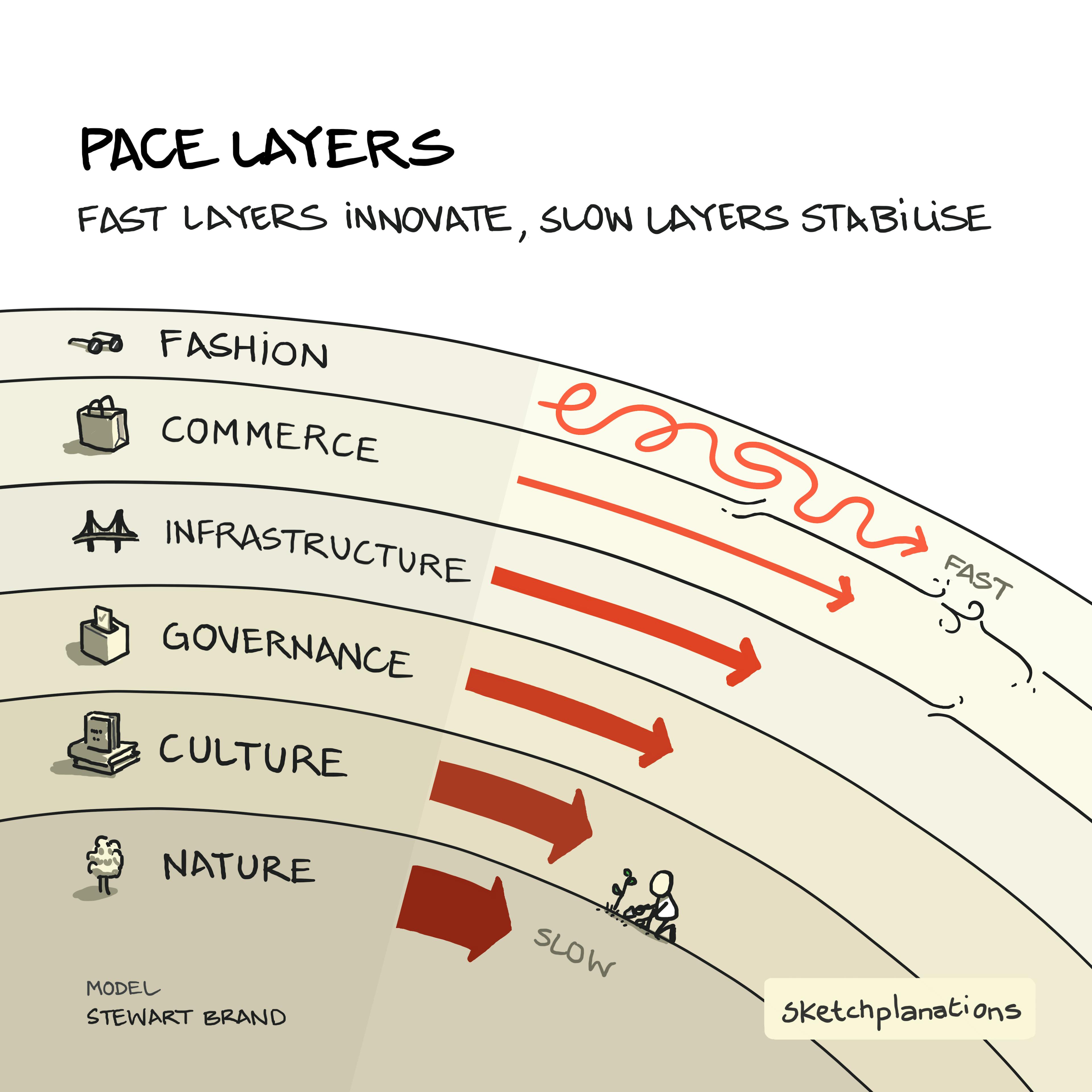Pace Layers: Six layers of robust and adaptable civilisations

- Prints
- Copied!
👇 Get new sketches each week
What makes a resilient system? It needs to be strong, but flexible. Pace Layers, sometimes called pace layering, is a framework created by Stewart Brand of the Long Now Foundation that explores how different parts of civilisation change at different speeds.
Fast-moving layers like fashion bring novelty and experimentation, while slower layers like culture and nature provide stability and memory. Together, the layers support, reinforce, and challenge each other—creating robust, adaptable societies.
Pace layers is a model I have come back to again and again.
What is the Pace Layers Framework?
The pace layering model has six levels, with each deeper layer moving more slowly than the one above it. In Brand's words:
- Fast learns, slow remembers.
- Fast proposes, slow disposes.
- Fast is discontinuous, slow is continuous.
- Fast and small instructs slow and big by accrued innovation and occasional revolution.
- Slow and big controls small and fast by constraint and constancy.
- Fast gets all our attention, slow has all the power.
In short: the fast layers innovate, the slow layers stabilise. Brand argued that all durable dynamic systems have this sort of structure—it’s what makes them adaptable and resilient.
According to pace layering, the six layers of pace and size in the working structure of a robust and adaptable civilisation are:
- Fashion/Art
- Commerce
- Infrastructure
- Governance
- Culture
- Nature
Pace Layering Example: Electric Scooters
An example brings pace layers home to me. Here, I consider electric scooters, but you can take almost any innovation and think through the layers.
Fashion/Art
New scooter designs, colours, marketing campaigns, and influencer hype cycles. These come and go quickly—some stick, most fade.
Commerce
Scooter rental startups, pricing models, venture capital funding, and competition with bikes, cars, and other transport. Commerce runs slower than fashion, but still moves quickly through experimentation.
Infrastructure
Charging docks, scooter lanes, designated parking areas, and integration with city planning—all these take time. Cities and transport systems have to adapt, if electric scooters persist, for them to thrive rather than die out.
Governance
The laws and regulations surrounding scooters often lag behind the pace of commerce, including speed limits, taxes, penalties, incentives, safety requirements, age restrictions, or bans. Governance responds as the effects of scooters unfold.
Culture
Culture in the deep sense of how this changes mobility and ideas around travel. It may affect socialising, where people work and live, and what we choose to do as a society. Culture evolves slowly as habits and norms change in tandem with governance and infrastructure.
Nature
The environmental realities of scooters vs other transport means. Batteries, natural resources, long-term sustainability, and the effect on the climate.
Applying the Pace Layers Model to AI
Applying pace layers to the growth and development of Artificial Intelligence (AI) is also instructive:
- Fashion: AI tools and interfaces change daily.
- Commerce: Models and capabilities change weekly or monthly. Companies compete on quarterly and annual cycles.
- Infrastructure: Investment, data centres and energy generation are being approved and built slowly.
- Governance: The rules, ethics, court cases, and legal challenges surrounding the regulation of AI content and companies are developing on a case-by-case basis.
- Culture: How AI changes work, employment, where people live, and power structures are all in progress.
- Nature: Effects on the planet, energy and climate take longer to play out.
AI can feel like it's changing every day, yet its deepest consequences will play out over decades and centuries.
Pace Layers and Time Hierarchy
In his book The Clock of the Long Now , Brand also discusses time hierarchy in nature. He describes a coniferous forest:
- The needle changes within a year.
- The tree crown over several years.
- The patch over many decades.
- The stand over a couple of centuries.
- The forest over a thousand years.
- The biome over ten thousand years.
The faster elements are constrained by the slower ones: the needle by the crown, the crown by the patch, and so on up to the biome. Yet innovation still percolates through the system via evolutionary competition. Occasionally, shocks—fire, disease, human activity—disrupt the whole structure, sometimes all the way to the biome.
You can see this idea in my sketch on Time Hierarchy.
Considering the Pace Layers Model
I find pace layers thinking interesting as a way to differentiate between the fast and slower changes I see around me. It helps me make better sense of the world and see the age-old tussle between innovation and stability.
Related Ideas to Pace Layers
Also see:
- Time Hierarchy
- The Overview Effect
- The Overton Window: the range of politically acceptable ideas
- Human pace
- The Gartner Hype Cycle
- Marchetti's Constant
- The Destiny Instinct
- The S-Curve
- The Law of Unintended Consequences
I revised my original pace layers sketch because I kept discussing it with people and thought it needed a better visual.
Read more on Pace Layers at the Long Now

